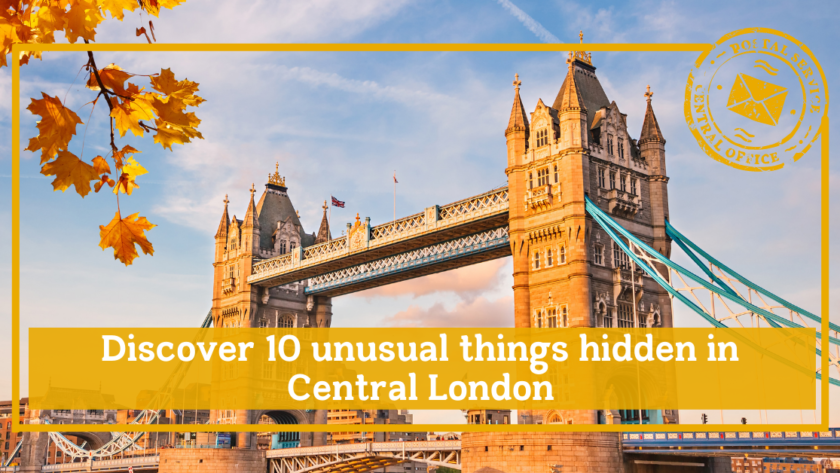You don’t need to look far to get lost in the incredibly enticing history of central London. Places like the Tower of London transport you back to its grisly past as Beefeaters engage you in their stories, and it’s exciting to visualise yourself strolling proudly through the decorated halls of Buckingham Palace as you peer through the railings out front. These popular sights are intriguing to visit and it can take weeks to see and experience everything. Every building seems to have a story. It’s not surprising that there are unusual things hidden in central London.
It can be easy to miss things as you walk by, in the hustle and bustle of it all. But if you look closely, unusual little gems are discovered that will make your adventure more unique and interesting. Most things are hidden in plain sight, just waiting for you to find them!
I’ve listed 10 things that I have found in central London that are different and quirky for you to uncover. Plus, it’s all free, so you save some pennies in this expensive city!
1. St Dunstan in the East
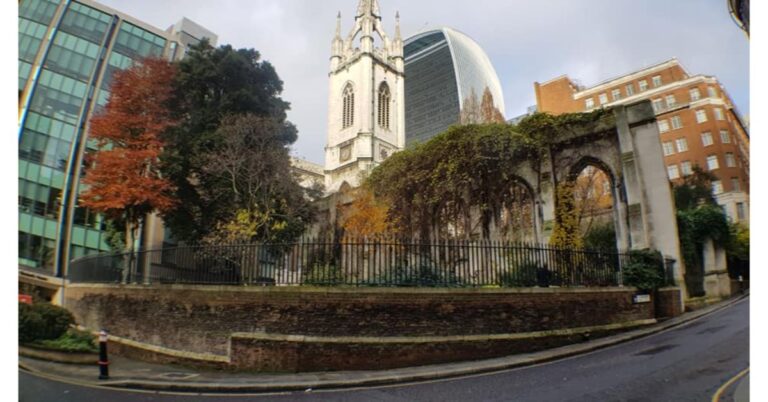
A beautiful church that is being reclaimed by nature. Hidden just off the busy main road of Lower Thames Street, at first your eyes can’t quite believe what you’re seeing. It’s a shell of a church, the rich green of the trees and vines against the light grey of the brick. It’s a startling contrast. Surrounded on three sides of this church are modern buildings which add to the surrealness.
Through the gates, the building is open to walk through. It has now been converted into a garden for anyone to enjoy. You are immediately transported into this serene atmosphere, cut off from the hectic modern day. The sky is open above you. A perfect place to sit and reflect, read a book, or eat your lunch.
This Gothic-style parish belonged to the Church of England and was originally built in 1100. However, it was drastically damaged during the Great Fire of London in 1666. It was repaired and Sir Christopher Wren even designed a new steeple for it. Disaster struck again during the Second World War and it was bombed during the Blitz in 1941. But this time it was not rebuilt but eventually repurposed into a public garden in 1971. It’s a unique find!
Location: St Dunstans Hill, EC3R 5DD.
Nearest tube station: smack-bang in the middle of Tower Hill and Monument stations on the circle and district lines.
2. The London stone
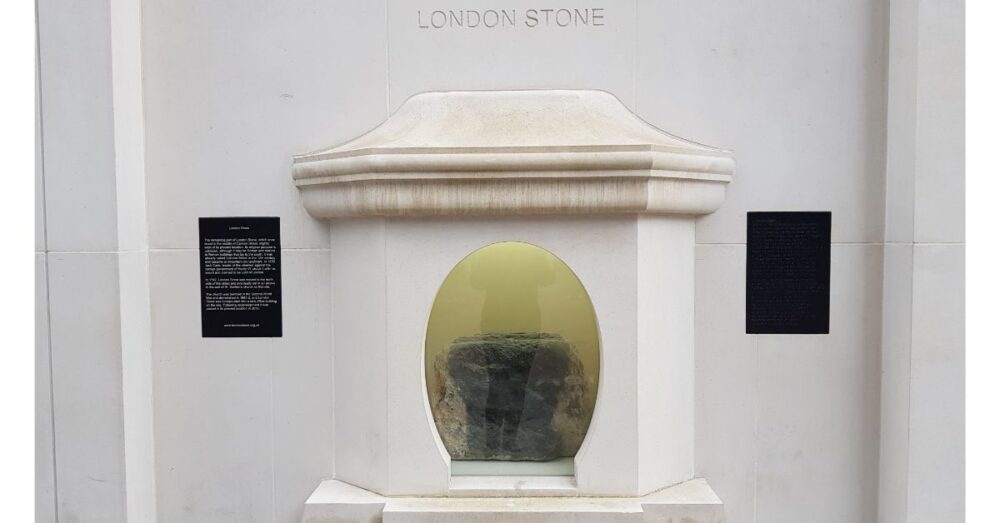
Walking down Cannon Street your focus will probably be on making the train home on time. It won’t be on an inconspicuous-looking stone settled in to a brick wall, quietly watching people rush by. It’s as if small oddities are normalised in central London, glazed over by tourists and locals alike. Until someone stops and really looks at it, that is. Hidden in the middle of this bustling main street is a block of limestone sat behind an oval glass window. This “London Stone” was first named so in 1100, possibly of Roman origin. No-one seems to know where it originated from or what its purpose was. But it has remained a landmark and even a tourist attraction since then. It has not moved far from its original location Cannon Street which was called Candlewick Street in Medieval times.
Aside from wild speculations about its use – from being a transport marker to occult uses – it’s featured in popular tales like King Arthur too. A great website to read about popular myths is the Museum of London. When you come across this stone take a moment out of your busy day to stop and look at it; imagine all the generations of people who have met up at this landmark, performed ceremonies, and – if you’re really imaginative – pulled a magical sword from it.
Location: 111, Cannon Street, EC4N 5AR.
The nearest train station & tube: Cannon Street.
3. Guildhall - Art gallery, ampitheatre, & crime museum

In the 800 years since it’s been built, the Guildhall is sure to always have something going on; from conferences to ceremonies with the Mayor of London. For everyday exploring it houses the art gallery and the Crime museum.
As you walk into the art gallery you are welcomed by a grand staircase, ascending with the promise of beautiful artwork. As you wander over the rich royal-red carpet you are surrounded by magnificent paintings, resting in their golden frames. If you visit on a Tuesday, Friday, or Saturday you will be treated to a free tour. This includes a venture down to the remains of the Roman ampitheatre below! Take a look at the art gallery here.
A two-minute walk from this beautiful building is the City Police Crime Museum, also free to visit. The City Police have looked after the square mile of London since 1839 and this small museum is a fun and interactive way to learn its unique history. Walking through the isles of old uniforms through the ages you can imagine yourself wearing it in the reflection in the glass. Like how Steve Rogers imagines himself being a soldier before his transformation into Captain America. There’s even a small section with police hats that you can try on – which I’m pretty sure is meant for kids, and I definitely didn’t try them on… I have no regrets.
Update: The City Police Crime Museum is currently closed. No re-open date has yet been posted.
Location of the Art gallery: Guildhall yard, off Gresham Street, EC2V 5AE.
Location of the Crime Museum: 2 Aldermanbury, EC2V 7HH. On the first floor of the library.
Nearest station: St Paul’s or Bank underground station.
4. Little compton street

It shouldn’t surprise anyone that there are hidden streets buried over time in central London. Sometimes remnants of some can still be seen, if you know where to look. This particular slice of history can be found in the middle of a busy road… I attracted some stares as I bent down to peer through the grate at this secret situated underneath everyone’s feet.
Little Compton street dates back to Victorian times. The story goes that when Charing Cross road was built over it in 1896, it was forgotten by the general public. After a little research, I found that it wasn’t a street to begin with at all. It was built to be a utility tunnel to keep up with the modernisation of London. Once my eyes adjusted to the gloom, I could make out the thick black cables running through it. The faded peeling signs of the street against the brick could just about be seen. They may well have belonged to the real Little Compton Street before it was demolished nearby, not built over. The signs would have been utilised as waypoints so workers in the tunnels didn’t get lost!
It was still great fun to discover this interesting obscurity underneath a grate on an island crossing. London traffic rumbling past unawares, just be mindful of the road!
Location: Charing Cross Road, by the junction of Old Compton Street.
The nearest underground stations: Leicester Square or Tottenham Court Road.
5. The seven noses of soho

People who visit Soho go to pubs, bars, restaurants, and even theatres. Although there are enough uniquely fun things to do to keep you busy for months, I found a slightly different way to spend an afternoon – searching for an interesting array of noses sculpted into walls.
It’s a good deal of walking but you get to see Soho and the surrounding area, and the treasure hunt was great fun! The morning was spent putting in their locations on Google Maps and then leading my partner on a wild goose chase. I didn’t realise there was a perfectly good guide online here. I also took pride in knowing where one of the noses was already! It was fun to show him the one at Admiralty Arch as our starting point.
The artwork was created by Rick Buckley in 1997 as the increasing amount of CCTV cameras around London garnered attention. It was a simple act to highlight this political protest. This adventure is made all the more fun by the abundance of pubs to refresh yourselves on the way!
Location: Soho area
The nearest station: Charing Cross if you want to start at Admiralty Arch.
6. Cholera pump
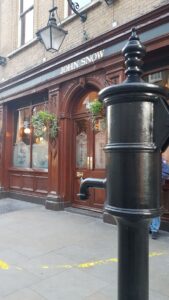
I’m one of those people who enjoy strange stories. Add a bit of history and morbidity and you’ve got yourself a keen listener. Imagine my excitement when I found out a water pump was the site of a major cholera outbreak in central London. I just had to see it!
This cholera outbreak in 1854 was the worst to hit the city. Scientists, however, could not figure out where the disease was originating from or how it was spreading. Enter Dr John Snow, who theorised that the disease was spreading through the drinking water. He just had to prove it. After some research and detective work, he found the water pump that was responsible for the outbreak. Eventually, he had the handle removed to prevent further cases.
So, he had found the origin of the outbreak. It was thought that it was due to the dirty water of the River Thames. But he eventually found that it was a cesspool nearby that had contaminated the pump.
The pump displayed outside the John Snow pub is sadly a replica, but it marks the spot of the original pump. It’s easy to imagine it being in use. Plus it’s fascinating to see a physical representation of the past that seamlessly blends in with the city surrounding it.
Location: Outside John Snow pub, 39 Broadwick Street, Soho, W1F 9QJ.
Nearest tube stations: Leicester Square or Tottenham Court Road.
7. Tomb of the unknown girl

In 1992, a bomb exploded in London. The IRA explosion severely damaged the Baltic Exchange Building and couldn’t be restored, and is now the site of the famous “Gherkin” which is one of the most recognisable sites in central London. The site was cleared in 1995 to make way for the Gherkin, and archeologists came across quite a surprise – the remains of a teenage girl who had lived in Roman times, when London was named Londinium. Her remains were 1,600 years old!
No one could figure out who she was, or how she ended up there, but she was eventually returned to her original resting place in 2007, and there was a procession with a ceremony to commemorate her re-burial. Now she lies under a dark grey marble slab in the quiet street behind the Gherkin, marked with a laurel wreath, and a plaque that reads “To the spirits of the dead / the unknown young girl / from Roman London / lies buried here”.
It’s a beautifully simple memorial, situated at the bottom of the Gherkin, but it’s not along the main road. The marble benches around it make a great place to take a seat and reflect on this fascinating slice of history.
Location: 30 St Mary Axe, London, EC3A 8BF.
Nearest tube station: Aldgate.
8. Oldest water fountain in london
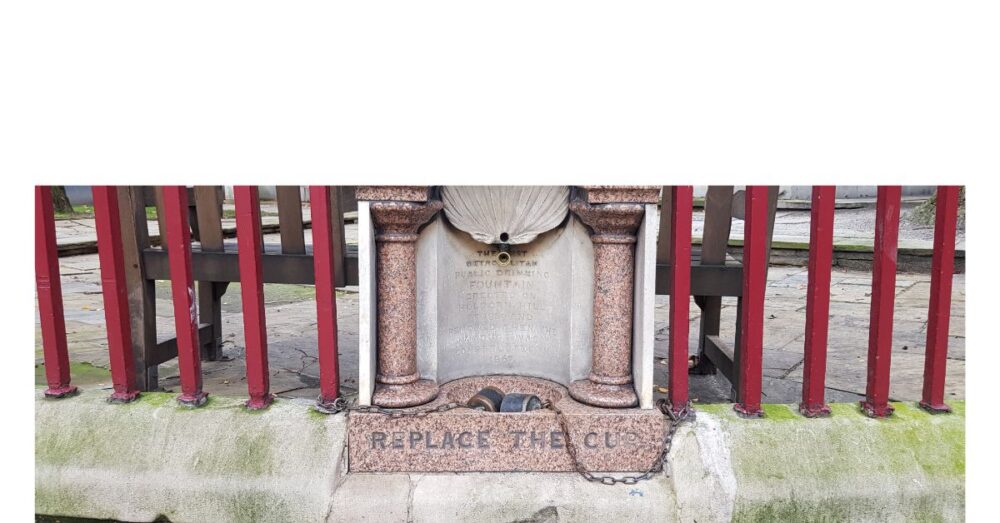
Aside from water pumps, which as we know were prone to cholera outbreaks, there were communal drinking fountains dotted around London for everyone to enjoy. I’m not even going to lie – you weren’t safe using these fancy-looking fountains either. Beer was considered a much safer option, which I’m sure we can all agree with. But they were useful if you were willing to risk it.
The first water fountain in central London still sits on a street corner in Holborn. It was built in 1859 in front of St Sepulchre-Without-Newgate church, and would be used by as many as 7,000 a day! The two cups chained to it was an idea used back then too, although I doubt you would want to put them to your lips now, even if the fountain was still in use. However, it promoted the idea that drinking water was now free for everyone. Progress! There’s even a handy little note inscribed underneath to “replace the cup” when finished. How thoughtful of them.
The organisation behind the implementation of these water fountains was called The Metropolitan Drinking Fountain and Cattle Trough Association, which has now been mercifully shortened to the Drinking Fountain Association and is still in charge of looking after these fountains today. They even constructed cattle troughs which proved to be hugely popular with the locals. Keep an eye out for them when exploring central London.
Location: At the junction of Giltspur Street and Holborn Viaduct.
The nearest underground station: St Paul’s.
9. Twinings tea shop

I’m a big fan of tea, and I love a Twinings cuppa, so I was so excited to visit the Twinings Tea shop and get some!
Britain used to be a coffee-loving nation, believe it or not. Tea wasn’t introduced until the 1660s by Catherine of Braganza, a Portuguese princess who married King Charles II in 1662. When Thomas Twining opened up his first coffee shop on the Strand, he eventually converted to selling just tea, and along with the East Indian Trade, the tea business took off.
The shop still stands there today; a short, narrow building, decorated white with simple designs. It is almost hidden among the taller and grander buildings on either side, but it stands tall in its way. As you walk past the herbal scents invite you in, and you might not emerge for a long time – the range of tea they have is astounding, and you can smell and sample every flavour. At the back of this narrow shop, a knowledgeable staff member waits to serve a hot tea of your choice to take away. Watching him slowly but thoroughly make the tea was a delight in itself, and on that particularly chilly afternoon it raised my spirits and refreshed me.
You don’t have to buy anything, it was fun trying samples, but it would be money well spent if you did. A hot drink to take away will only set you back a couple of pounds.
Location: 216 Strand, London, WC2R 1AP.
The nearest underground: Temple.
10. The hardy tree
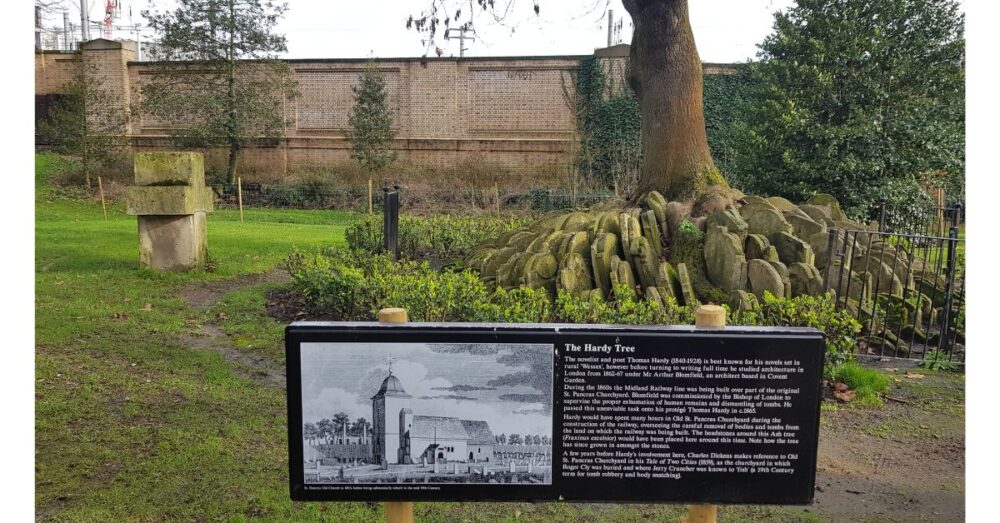
This isn’t a sight you would normally see in a cemetery, and the story behind it was interesting enough to make me want to check it out. As you make your way around Saint Pancras Gardens it seems like an ordinary place, as far as cemeteries go, until you come across an ash tree; standing tall amongst an assortment of gravestones, the headstones placed around it in a circle like a teacher telling a story to her class of schoolchildren.
It could not have originally been planned like that, surely, but you soon find out the truth when you approach the plaque before it. The cemetery is considered one of England’s oldest places for Christian worship, but by the mid-1860s London’s railway needed expanding, and this expansion was to go through the gardens of St Pancras church.
An architecture firm was hired to exhume the graves and bury them at another site, and who should get this rather grisly job but Thomas Hardy, who went on to be an accomplished author? It was his idea to arrange the leftover headstones in such a pattern, and it’s beautiful. As you stand before it you are glad that they weren’t gone to waste.
Location: St Pancras Gardens, Camley Street, London, NW1 0PS.
The nearest railway station: Kings Cross / St Pancras International.
Get out there & explore central London
There’s a multitude of bars, cafes, and restaurants in central London to keep you well-rested along the way. I’ve developed a craving for hot chocolates lately that I used as a good excuse to visit as many as I could. Here are my top three recommendations.
Central London is so diverse it can fit everyone’s tastes. If you want to discover something different and have a more unusual day that won’t make you dread looking at your bank account at the end of your trip, these are some good places to start. Keep exploring!

